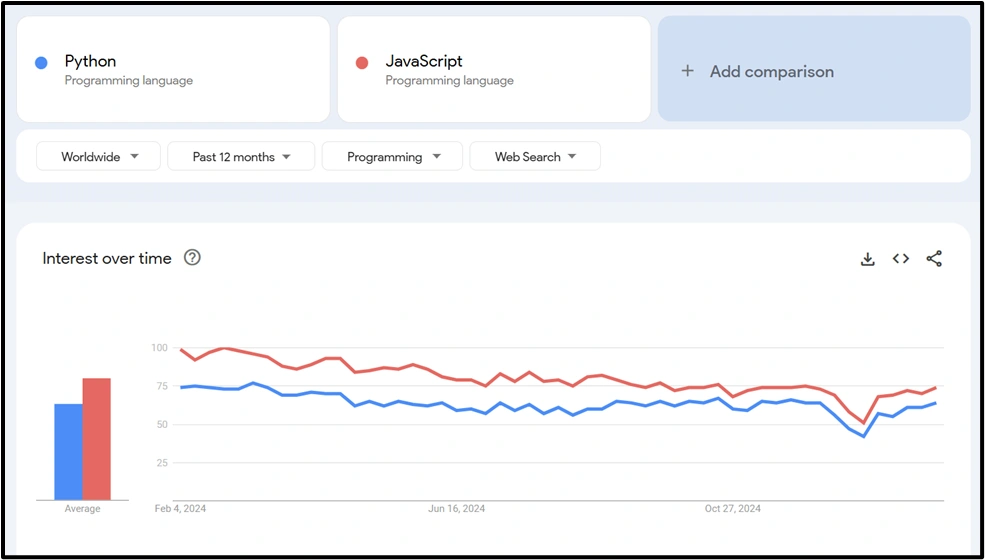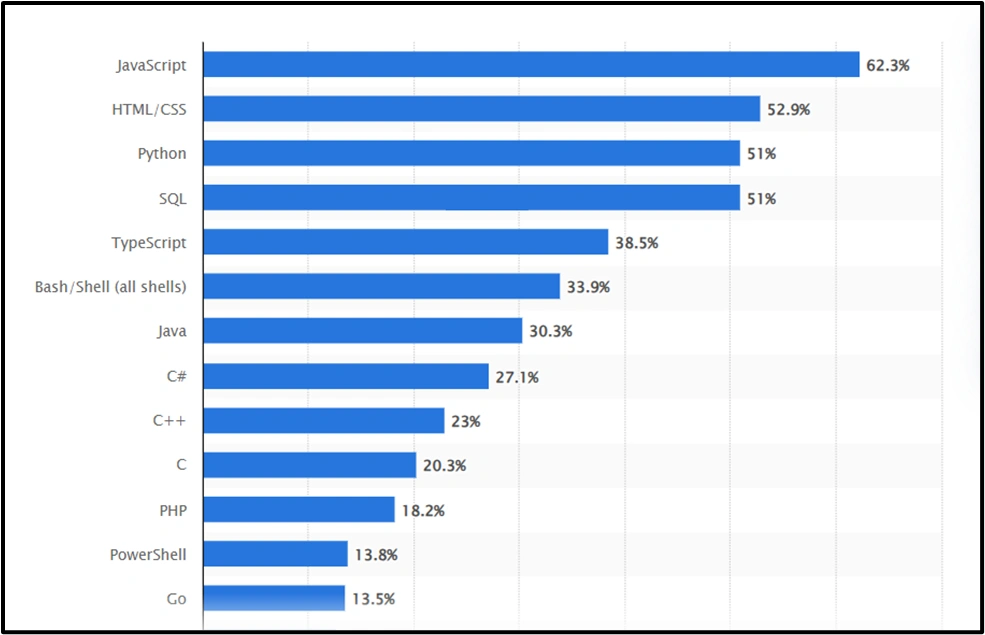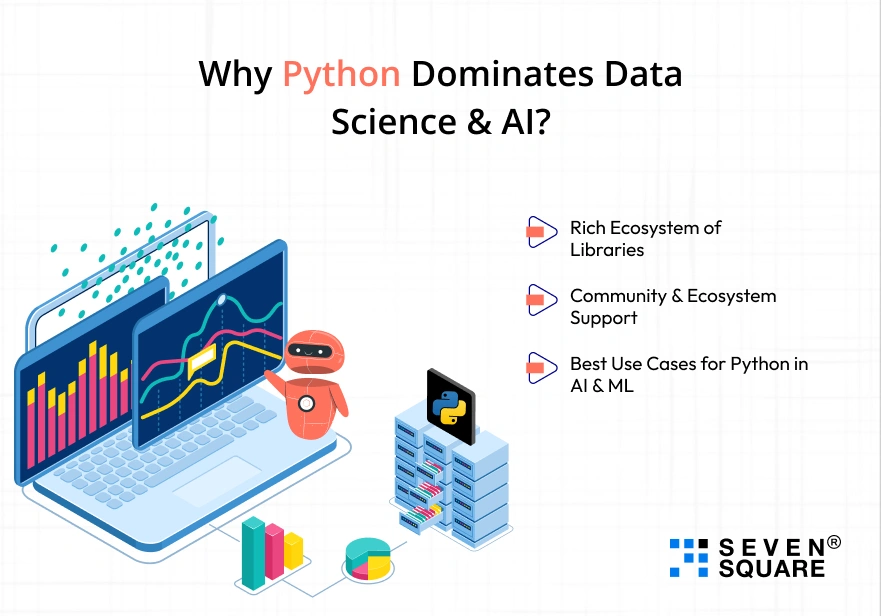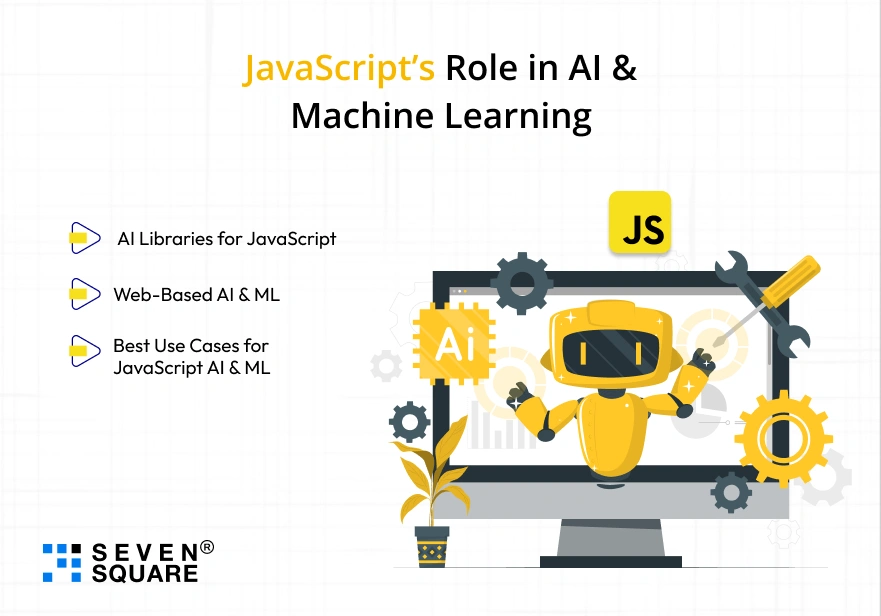When it comes to modern programming, two names stand out: Python and JavaScript.
Both languages are widely used and incredibly popular, and they can be used in everything from web development to machine learning.
But if you’re starting a new project, you might be wondering: Python or JavaScript, Which one is the better choice?
Why Are Python and JavaScript So Popular?
- Python is widely used in data science, AI, machine learning, automation, and backend development.
- JavaScript is used in websites, single-page applications (SPAs), and full-stack development with frameworks like React, Angular, and Node.js.
In this blog, we tried to compare Python vs JavaScript based on different aspects like performance, syntax, web development, and machine learning.
We hope by the end of the blog you will have a clear understanding of JavaScript vs Python comparison so that you can choose the best language for your next project.

Source: Google Trends
Python vs JavaScript: Key Differences
Choosing between Python or JavaScript for your project depends on various factors like syntax, performance, and use cases.
Both are powerful languages but they are used for different purposes and best in different areas. Let’s see their key differences.
1. Syntax: Readability vs Flexibility
- Python: Known for its simple, clean, and readable syntax as Python is beginner-friendly and focuses on code readability. It uses indentation instead of brackets, making it easier to write and understand.
- Example (Python):
def greet(name):
print(“Hello, ” + name)
greet(“Alice”)
- Example (Python):
- JavaScript: JavaScript has a more flexible and dynamic syntax that allows multiple ways to write the same function. It uses curly braces {} and semicolons (;) which can sometimes lead to errors if not used properly.
- Example (JavaScript):
function greet(name) {
console.log(“Hello, ” + name);
}
greet(“Alice”);
- Example (JavaScript):
- Which is better: If you prefer clean and easy-to-read code then Python is best for you. If you like flexibility and don’t mind syntax complexity then JavaScript is a great choice.
2. Performance: Speed and Execution
- JavaScript:
- It is faster because it runs in web browsers using a Just-In-Time (JIT) compiler to improve the speed of execution.
- That’s why JavaScript is ideal for real-time applications like chat apps and interactive web pages.
- Python:
- It is slower because it is an interpreted language because the code is executed line by line.
- However, it is best for data-heavy applications like machine learning and data science where raw speed is less critical.
- Which is better: If execution speed is your priority then JavaScript wins. But if your project focuses on AI, data science, and backend automation then Python is the better choice.
Use Cases: Where Each Language is Most Effective?
| Feature | Python | JavaScript |
| Web Development | Used for backend (Django, Flask) | Frontend & backend (React, Node.Js) |
| Data Science & AI | Best choice (TensorFlow, Pandas) | Limited Support (TensorFlow.js) |
| Mobile App Development | Limited (Kivy, BeeWare) | Strong (React Native) |
| Game Development | Used in AI-based games | Popular for browser-based games |
| Automation & Scripting | Best for automation | Not commonly used |
- Which is better: Choose JavaScript if you’re building web apps, real-time apps, and mobile apps. Python if you’re working on AI, machine learning, and backend automation.
Understanding the key differences between Python vs JavaScript helps you make a better decision.
While Python is best for AI, data science, and backend development, JavaScript dominates web development and interactive applications.
Python vs JavaScript for Web Development: Which One is Right for You?
When it comes to web development, both Python and JavaScript play a major role but in different ways.
JavaScript is the backbone of front-end and full-stack development, while Python is a powerful choice for backend development and automation.
JavaScript for Web Development
JavaScript is one of the most widely used languages for web development to build interactive and dynamic websites. Here’s how it helps in web development:
1. Front-End Development
JavaScript is necessary for creating dynamic and interactive user interfaces. Popular JavaScript frameworks include:
- React.js : Best to build single-page applications (SPAs) and dynamic UIs.
- Angular.js : A powerful enterprise-level framework for large-scale applications.
- Vue.js : A lightweight and flexible framework for progressive web apps (PWAs).
2. Server-Side Development with Node.js
JavaScript isn’t just for front-end development but also works on the backend with Node.js.
- Node.js allows JavaScript to run on servers and makes it possible to build full-stack web applications using a single language.
- It is known for high performance, handling thousands of simultaneous connections in real time (perfect for chat apps, gaming platforms, and live streaming).
3. Why Choose JavaScript?
- Best for dynamic, interactive web applications.
- Ideal for full-stack development with frameworks like Node.js and React.
- Faster execution speed due to JIT (Just-In-Time) compilation.
Python for Web Development
While Python is not common in front-end development, it is one of the best choices for backend development and API development.
1. Backend Development with Django and Flask
- Django: A high-level web framework that follows the “batteries-included” approach to make web development faster and more secure.
- Flask: A lightweight and flexible framework that is ideal for small to medium-sized applications..
Python’s backend frameworks make it easy to handle user authentication, database management, and API integration.
2. API Development and Automation
- Python is widely used for building APIs that connect front-end applications with databases.
- It is also great for automation scripts which help in data scraping, testing, and DevOps tasks.
3. Why Choose Python?
- Best for backend development with Django and Flask.
- Great for building RESTful APIs and handling automation.
- Highly scalable and secure, making it a good choice for enterprise applications.
Which One Should You Choose?
The choice between Python or JavaScript depends on your project requirements:
| Basis | JavaScript | Python |
| Best for Front-End? | Yes (React, Vue, Angular) | No |
| Best for Full-Stack? | Yes (Node.Js) | Limited |
| Best for Backend? | Yes (Node.Js) | Yes (Django, Flask) |
| Best for APIs? | Yes | Yes |
| Best for Automation? | No | Yes |
| Scalability? | High (Microservices, Cloud-based) | High (Enterprise applications) |
- Choose JavaScript if you are building a highly interactive web application and need full-stack development capabilities.
- Choose Python if you need a robust backend, API development, and automation features.

Source: Statista
Python vs JavaScript for Data Science & Machine Learning: Which One to Choose?
When it comes to data science and machine learning, Python vs JavaScript is not even a close battle as Python dominates the field.
However, JavaScript is making progress in AI and ML, especially for web-based applications.
Why Python Dominates Data Science & AI?

Python is the most popular language for data science, machine learning (ML), and artificial intelligence (AI) because of its:
1. Rich Ecosystem of Libraries:
Python offers powerful libraries that simplify data analysis and AI model development:
- Pandas : Handles data manipulation and analysis.
- NumPy : Supports mathematical operations and multidimensional arrays.
- TensorFlow & PyTorch : Industry-standard frameworks for machine learning and deep learning.
- Scikit-Learn : Provides tools for predictive analytics and statistical modeling.
2. Community & Ecosystem Support:
- With thousands of contributors, Python has a huge community that continuously improves its AI and ML capabilities.
3. Best Use Cases for Python in AI & ML:
- Predictive analytics
- Deep learning & neural networks
- Big data processing
- Natural language processing (NLP)
- Automation & AI-driven applications
JavaScript’s Role in AI & Machine Learning

Although JavaScript is not as dominant as Python in AI, it has gained traction with web-based machine learning.
1. AI Libraries for JavaScript
- TensorFlow.js : Allows machine learning models to run in the browser.
- Brain.js : A simple library for neural networks and AI models in JavaScript.
- Synaptic.js : Helps create neural networks for web applications.
2. Web-Based AI & ML
JavaScript is ideal for running AI models directly in a browser which makes it useful for:
- Real-time image and voice recognition
- AI-powered chatbots
- Interactive AI-based web apps
3. Best Use Cases for JavaScript AI & ML:
- Browser-based AI applications
- Client-side machine learning
- AI-based chatbots and real-time apps
Which one is better?
Choosing between Python or JavaScript for AI and ML depends on your project’s goals:
| Basis | Python | JavaScript |
| Best for AI & ML? | Yes (Industry-standard) | Limited |
| Library Support? | Extensive (TensorFlow, PyTorch, Pandas) | Fewer options |
| Ease of Use? | Beginner-friendly | More complex for AI |
| Speed & Performance? | Faster for AI/ML tasks | Slower for large-scale AI models |
| Best for Web AI? | No (Needs backend) | Yes (Browser-based AI) |
- If you are building a full-scale AI & ML project then Python is the best choice.
- If you need AI features in a web app & browser then JavaScript (TensorFlow.js) is a good option.
Python vs JavaScript Performance Comparison: Which One is Faster?
When choosing Python or JavaScript for your project, performance is a key factor.
Let’s compare Python vs JavaScript in terms of execution speed, real-time applications, and heavy computations.
Execution Speed: JavaScript vs Python
One of the biggest differences between JavaScript and Python is how they execute code.
1. JavaScript: Faster Execution with JIT Compilation
- JavaScript is a Just-In-Time (JIT) compiled language and it compiles code while running it which makes execution faster and more efficient.
- This is why JavaScript is the preferred choice for web applications that require high-speed performance.
2. Python: Slower Execution Due to Interpretation
- Python is an interpreted language, meaning it executes code line by line instead of compiling it before.
- This makes Python slower than JavaScript in general, especially for applications that require real-time responsiveness.
3. Winner
- JavaScript is faster than Python in execution speed which makes it a better choice for performance-driven web applications.
Real-Time Applications: JavaScript Wins
- Event-driven architecture (Handles multiple requests at once)
- Non-blocking I/O (Doesn’t pause execution while waiting for a task to complete)
- Fast execution speed (Ideal for dynamic web apps)
1. Best Use Cases for JavaScript in Real-Time Applications:
- Chat applications (WhatsApp Web)
- Online gaming (multiplayer games)
- Live stock market apps
- Streaming platforms (YouTube, Twitch)
Winner:
- JavaScript is better for real-time and interactive applications like chat apps and gaming platforms.
Python vs JavaScript for Performance
| Basis | Python | JavaScript |
| Execution Speed | Slower (Interpreted language) | Faster (JIT compilation) |
| Real-Time Applications | Not ideal | Best for interactive apps |
| Heavy Computations | Best for AI, ML, and big data | Not optimized for heavy processing |
- If you need speed and real-time interactivity then JavaScript is the winner.
- If your project involves data processing, AI, and complex algorithms then Python is the best choice.
The decision between Python vs JavaScript depends on your project’s performance needs and scalability requirements.
Python vs JavaScript: A Side-by-Side Comparison
Here’s a detailed comparison of Python vs JavaScript based on key factors like syntax, performance, use cases, and many more.
| Factor | Python | JavaScript |
| Syntax | Simple, readable, and beginner-friendly | Flexible, slightly complex, and requires more syntax knowledge |
| Performance | Slower (interpreted language) | Faster (JIT compilation) |
| Execution Speed | Slower because of line-by-line interpretation | Faster because of Just-In-Time (JIT) compilation |
| Web Development | Used for backend (Django, Flask) | Used for both frontend (React, Vue, Angular) and backend (Node.Js) |
| Data Science & AI | Best choice (Pandas, NumPy, TensorFlow, Scikit-learn) | Limited support (TensorFlow.js, Brain.js) |
| Machine Learning | Preferred due to extensive libraries | Less popular, limited libraries |
| Real-Time Applications | Not ideal, slower execution | Best choice (non-blocking I/O, event-driven architecture) |
| Mobile App Development | Limited support (Kivy, BeeWare) | Strong support with React Native |
| Scalability | Good for large-scale applications | Highly scalable for web apps and microservices |
| Ease of Learning | Easier due to clean and simple syntax | Slightly harder due to syntax complexity |
| Security | More secure due to robust backend handling | Requires additional security measures for web apps |
| Community Support | Strong (Popular in AI, ML, and backend development) | Very strong (Popular in web and full-stack development) |
| Best Use Cases | AI, Machine Learning, Data Science, Automation, Backend Development | Web Development, Real-Time Apps, Frontend Development, Mobile Apps |
Which Language is Best for Your Next Project?
Choosing between Python or JavaScript depends on your project’s goals, complexity, and performance needs.
Choose Python if….
Python is the perfect choice if you are working on:
1. AI, Machine Learning, and Data Science
- Python dominates the AI and ML space with powerful libraries like TensorFlow, Scikit-learn, and PyTorch.
- Best for big data analysis, automation, and predictive modeling.
2. Backend Development with Easy-to-Read Code
- Python is beginner-friendly with a clean and readable syntax to make development faster and easier.
- Frameworks like Django and Flask allow for scalable and secure backend applications.
3. Automation & Scripting
- Python is widely used for automating tasks, writing scripts, and data scraping.
- It’s a go-to language for devops, cybersecurity, and workflow automation.
Choose JavaScript If….
JavaScript is the best option when developing:
1. Web Applications & Interactive Websites
- JavaScript is the backbone of modern web development that supports both frontend (React, Angular, Vue.Js) and backend (Node.js).
- Perfect for creating dynamic and interactive websites that provide flawless user experiences.
2. High-Performance Real-Time Applications
- JavaScript’s event-driven, non-blocking architecture makes it perfect for real-time apps like chat apps, live streaming, and multiplayer games.
- Used in high-speed applications where instant user interaction is required.
3. Mobile App Development
- React Native enables developers to build cross-platform mobile applications using JavaScript.
- Faster development cycle compared to native app development.
Want to Get More Insights for Your Next Project? Connect with UsNow!
FAQs
- It depends on your project.
- Python is better for AI, machine learning, and backend development, while JavaScript is the best choice for web development, frontend UI, and real-time applications.
- Yes, Python has a simpler and more readable syntax, making it easier for beginners.
- JavaScript has more complex syntax and requires understanding concepts like callbacks, event loops, and asynchronous programming.
- Python is the best choice for AI and machine learning because of its extensive libraries like TensorFlow, PyTorch, Scikit-learn, and Pandas.
- JavaScript has TensorFlow.js and Brain.js but it is not as widely used in the AI/ML field.
- Yes, JavaScript is faster than Python because of its Just-In-Time (JIT) compilation that allows it to execute code quickly.
- Python is an interpreted language which makes it slower, especially for real-time applications.
- Yes, but it’s not commonly used. Python frameworks like Kivy and BeeWare support mobile app development but JavaScript (React Native) is more popular for building cross-platform mobile apps.
- Both are in high demand but for different roles:
- Python is widely used in AI, machine learning, backend development, and automation.
- JavaScript is the top choice for web development, front-end frameworks, and full-stack development.